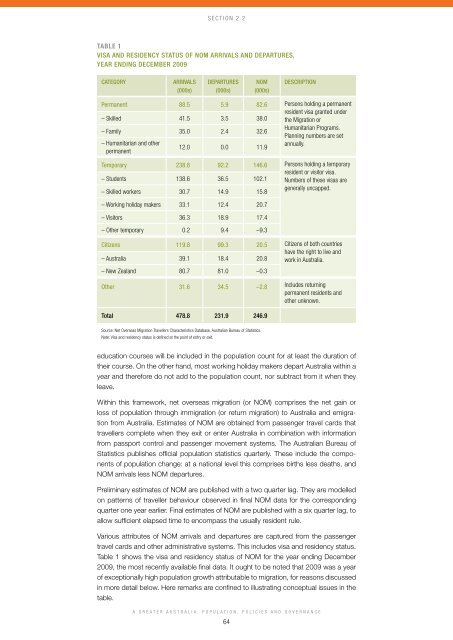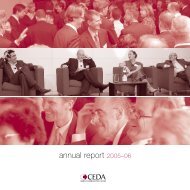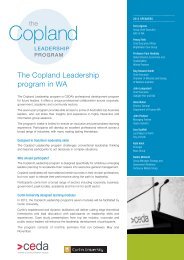A Greater Australia: Population, policies and governance - CEDA
A Greater Australia: Population, policies and governance - CEDA
A Greater Australia: Population, policies and governance - CEDA
- No tags were found...
Create successful ePaper yourself
Turn your PDF publications into a flip-book with our unique Google optimized e-Paper software.
Section 2.2Table 1Visa <strong>and</strong> residency status of NOM arrivals <strong>and</strong> departures,year ending December 2009CategoryArrivals(000s)Departures(000s)NOM(000s)DescriptionPermanent– Skilled88.541.55.93.582.638.0Persons holding a permanentresident visa granted underthe Migration or– Family 35.0 2.4 32.6Humanitarian Programs.Planning numbers are set– Humanitarian <strong>and</strong> otherannually.12.0 0.0 11.9permanentTemporary– Students238.8138.692.236.5146.6102.1Persons holding a temporaryresident or visitor visa.Numbers of these visas are– Skilled workers 30.7 14.9 15.8generally uncapped.– Working holiday makers 33.1 12.4 20.7– Visitors 36.3 18.9 17.4– Other temporary 0.2 9.4 –9.3Citizens– <strong>Australia</strong>119.839.199.318.420.520.8Citizens of both countrieshave the right to live <strong>and</strong>work in <strong>Australia</strong>.– New Zeal<strong>and</strong> 80.7 81.0 –0.3Other 31.6 34.5 –2.8 Includes returningpermanent residents <strong>and</strong>other unknown.Total 478.8 231.9 246.9Source: Net Overseas Migration Travellers Characteristics Database, <strong>Australia</strong>n Bureau of Statistics.Note: Visa <strong>and</strong> residency status is defined at the point of entry or exit.education courses will be included in the population count for at least the duration oftheir course. On the other h<strong>and</strong>, most working holiday makers depart <strong>Australia</strong> within ayear <strong>and</strong> therefore do not add to the population count, nor subtract from it when theyleave.Within this framework, net overseas migration (or NOM) comprises the net gain orloss of population through immigration (or return migration) to <strong>Australia</strong> <strong>and</strong> emigrationfrom <strong>Australia</strong>. Estimates of NOM are obtained from passenger travel cards thattravellers complete when they exit or enter <strong>Australia</strong> in combination with informationfrom passport control <strong>and</strong> passenger movement systems. The <strong>Australia</strong>n Bureau ofStatistics publishes official population statistics quarterly. These include the componentsof population change: at a national level this comprises births less deaths, <strong>and</strong>NOM arrivals less NOM departures.Preliminary estimates of NOM are published with a two quarter lag. They are modelledon patterns of traveller behaviour observed in final NOM data for the correspondingquarter one year earlier. Final estimates of NOM are published with a six quarter lag, toallow sufficient elapsed time to encompass the usually resident rule.Various attributes of NOM arrivals <strong>and</strong> departures are captured from the passengertravel cards <strong>and</strong> other administrative systems. This includes visa <strong>and</strong> residency status.Table 1 shows the visa <strong>and</strong> residency status of NOM for the year ending December2009, the most recently available final data. It ought to be noted that 2009 was a yearof exceptionally high population growth attributable to migration, for reasons discussedin more detail below. Here remarks are confined to illustrating conceptual issues in thetable.A <strong>Greater</strong> <strong>Australia</strong>: <strong>Population</strong>, Policies <strong>and</strong> Governance64





